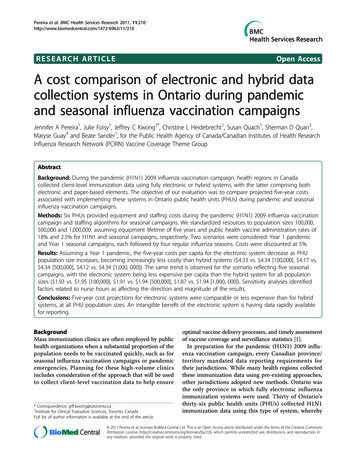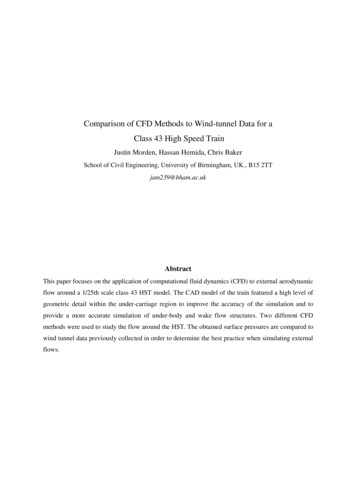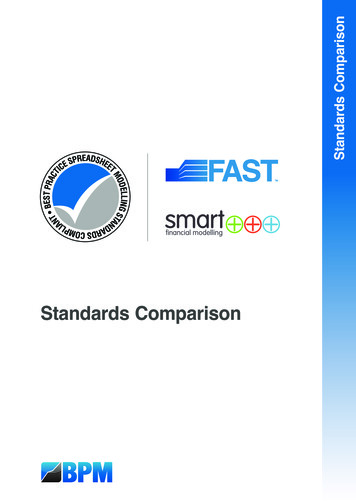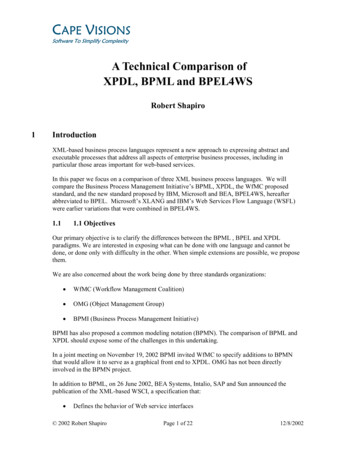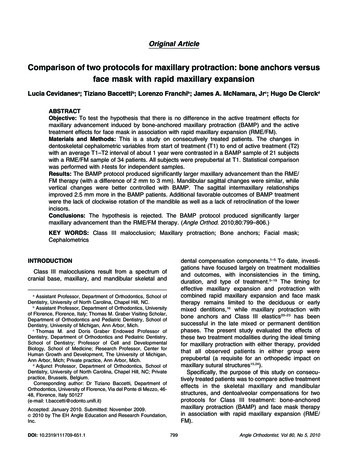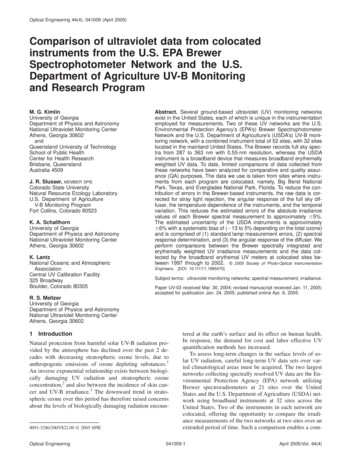
Transcription
Optical Engineering 44(4), 041009 (April 2005)Comparison of ultraviolet data from colocatedinstruments from the U.S. EPA BrewerSpectrophotometer Network and the U.S.Department of Agriculture UV-B Monitoringand Research ProgramM. G. KimlinUniversity of GeorgiaDepartment of Physics and AstronomyNational Ultraviolet Monitoring CenterAthens, Georgia 30602andQueensland University of TechnologySchool of Public HealthCenter for Health ResearchBrisbane, QueenslandAustralia 4509J. R. Slusser, MEMBER SPIEColorado State UniversityNatural Resource Ecology LaboratoryU.S. Department of AgricultureV-B Monitoring ProgramFort Collins, Colorado 80523K. A. SchallhornUniversity of GeorgiaDepartment of Physics and AstronomyNational Ultraviolet Monitoring CenterAthens, Georgia 30602K. LantzNational Oceanic and AtmosphericAssociationCentral UV Calibration Facility325 BroadwayBoulder, Colorado 80305Abstract. Several ground-based ultraviolet (UV) monitoring networksexist in the United States, each of which is unique in the instrumentationemployed for measurements. Two of these UV networks are the U.S.Environmental Protection Agency’s (EPA’s) Brewer SpectrophotometerNetwork and the U.S. Department of Agriculture’s (USDA’s) UV-B monitoring network, with a combined instrument total of 52 sites, with 32 siteslocated in the mainland United States. The Brewer records full sky spectra from 287 to 363 nm with 0.55-nm resolution, whereas the USDAinstrument is a broadband device that measures broadband erythemallyweighted UV data. To date, limited comparisons of data collected fromthese networks have been analyzed for comparative and quality assurance (QA) purposes. The data we use is taken from sites where instruments from each program are colocated, namely, Big Bend NationalPark, Texas, and Everglades National Park, Florida. To reduce the contribution of errors in the Brewer-based instruments, the raw data is corrected for stray light rejection, the angular response of the full sky diffuser, the temperature dependence of the instruments, and the temporalvariation. This reduces the estimated errors of the absolute irradiancevalues of each Brewer spectral measurement to approximately 5%.The estimated uncertainty of the USDA instruments is approximately 6% with a systematic bias of ( 13 to 5% depending on the total ozone)and is comprised of (1) standard lamp measurement errors, (2) spectralresponse determination, and (3) the angular response of the diffuser. Weperform comparisons between the Brewer spectrally integrated anderythemally weighted UV irradiance measurements and the data collected by the broadband erythemal UV meters at colocated sites between 1997 through to 2002. 2005 Society of Photo-Optical InstrumentationEngineers. [DOI: 10.1117/1.1885470]Subject terms: ultraviolet monitoring networks; spectral measurement; irradiance.Paper UV-03 received Mar. 30, 2004; revised manuscript received Jan. 11, 2005;accepted for publication Jan. 24, 2005; published online Apr. 6, 2005.R. S. MeltzerUniversity of GeorgiaDepartment of Physics and AstronomyNational Ultraviolet Monitoring CenterAthens, Georgia 306021IntroductionNatural protection from harmful solar UV-B radiation provided by the atmosphere has declined over the past 2 decades with decreasing stratospheric ozone levels, due toanthropogenic emissions of ozone depleting substances.1An inverse exponential relationship exists between biologically damaging UV radiation and stratospheric ozoneconcentration,2 and also between the incidence of skin cancer and UV-B irradiance.3 The downward trend in stratospheric ozone over this period has therefore raised concernsabout the levels of biologically damaging radiation encoun-0091-3286/2005/ 22.00 2005 SPIEOptical Engineeringtered at the earth’s surface and its effect on human health.In response, the demand for cost and labor effective UVquantification methods has increased.To assess long-term changes in the surface levels of solar UV radiation, careful long-term UV data sets over varied climatological areas must be acquired. The two largestnetworks collecting spectrally resolved UV data are the Environmental Protection Agency 共EPA兲 network utilizingBrewer spectroradiometers at 21 sites over the UnitedStates and the U.S. Department of Agriculture 共USDA兲 network using broadband instruments at 32 sites across theUnited States. Two of the instruments in each network arecolocated, offering the opportunity to compare the irradiance measurements of the two networks at two sites over anextended period of time. Such a comparison enables a com-041009-1April 2005/Vol. 44(4)
Kimlin et al.: Comparison of ultraviolet data . . .Table 1 Uncertainty estimate for clear-sky daily dose of erythema from YES-UVB radiometers at BigBend, Texas and Everglades, Florida.Uncertainty ContributionUncertainty SourceCommentsRandom 5% 1%SpectroradiometerTransfer from triadAngular response (AR)Spectral response (SR)OzoneSystematicContribution ofdifferences in AR toerrorContribution ofdifference in SR toerror 3% 1%200 DU: 13%Contribution of errorto daily dose300 DU: 0%400 DU: 5%Temperature 0.1%Total 6%parison of the relative absolute calibrations of the instruments, their relative stability with time, and potentialsources of residual error in the resulting data.2Instrumentation and Methodology2.1 Ground-Based Instruments2.1.1 University of Georgia (UGA)/EPA Brewerspectroradiometer and data correctionThe UV irradiance measurements were obtained usingMkIV Brewer instruments in the UGA/EPA Brewer network that record spectra in 0.55-nm steps over the UVspectral range of 286.5 to 363 nm. From this point forwardin the paper, these instruments are referred to as UGA/EPA.UV irradiance calibrations, using a secondary standardlamp traceable to a National Institute of Standards andTechnology 共NIST兲 1000-W lamp, are performed at thesites by staff of the UGA’s National UV Monitoring Center共NUVMC兲 approximately once per year. The fully corrected Brewer data uses an estimated daily temporal response based on the annual UV irradiance calibration. Additionally, independent quality assurance audits of theinstruments take place by staff of the National Oceanic andAtmospheric Administration 共NOAA兲.Regular 共quarterly兲 checks on transfer of the calibrationfrom the NIST 1000-W lamp to the traveling secondarystandard were performed at the NUVMC. The responsefunction of each instrument is calculated for each day basedon a linear interpolation between the two temporally closestresponse functions. The temporal corrections typically increase the UV irradiance relative to that of the uncorrecteddata, which assumes the last response, since usually theinstrument response decreases with time such that the actual response is less than that assumed based simply on thelast calibration. Brewer data were corrected for dark count,dead time, and stray light using the algorithms of Sci-Tec.4The data are then corrected for the instrument’s cosineresponse and temperature dependence. Each instrument ischaracterized for the angular dependence of its response atOptical Engineering 13 to 5%5-deg increments along two mutually perpendicular directions. A standard operating procedure 共SOP兲 available atthe UGA Website 共http://oz.physast.uga.edu兲 describes thisprocess. A correction is then applied under the assumptionof a diffuse isotropic clear sky and a ratio of the direct/global irradiance based on a clear-sky model of Rundel.5The cosine correction leads to an increase in the UV irradiance relative to that of the uncorrected data since the fullsky collector operates at a reduced throughput for rays atlarge angles from the zenith, the angle for which the instrument is calibrated. The wavelength-dependent temperaturecoefficient of each instrument has been characterized in thefield using a specially stabilized 50-W Brewer calibrationlamp, throughout 1 day during the diurnal temperaturecycle. The wavelength dependent temperature coefficient istypically about 0.1 to 0.4% per degree centigrade, but itcan be as large as 1% per degree centigrade in some wavelength ranges.6 Temperature corrections to the deep UV共DUV兲 can be positive or negative, depending on the relative temperature of a UV scan to that of the temperaturewhen the calibrations were performed.2.1.2 USDA broadband instrumentThe USDA’s UV-B Monitoring Program’s UV data set usedin this research was derived from broadband UV sensors attwo of their sites operating in the continental United States.The USDA’s UV Network uses Yankee Environmental System 共YES兲 UV-B1 broadband radiometers. A general overview of the design of this type of broadband radiometer isgiven in Berger et al.7 From this point forward in this paper, these instruments will be referred to as USDA. Data iscollected at each site in 3-min intervals throughout thecourse of the day. These sensors have the advantages ofmechanical simplicity and a high measurement frequency,and the resulting data set enables detailed studies of thetemporal behavior in UV irradiance. The limitation is thatthe broadband information alone does not enable unambiguous attribution of observed variability to a specificcause, such as a change in ozone or in cloudiness. Eachbroadband radiometer is characterized annually for spectral041009-2April 2005/Vol. 44(4)
Kimlin et al.: Comparison of ultraviolet data . . .Table 2 Measurement site parameters.SiteLongitudeAlt. (m)ObstructionsBig Bend Brewer29.31 deg N103.13 deg W1131Everglades Brewer25.39 deg N80.68 deg W0Mountain obstructionto 15 deg, SUnobstructed1997 to20021997 to2001Big Bend USDA29.13 deg N103.52 deg W6701997 to2002Everglades25.38 deg N80.68 deg W0Slight horizonobstruction bymountainUnobstructedand cosine response. The absolute calibration of eachUSDA radiometer is performed annually by comparing theoutput of the broadband sensor in sunlight with that of threecollocated YES UV-B1 standard radiometers 共the CUCFtriad兲 for 2 weeks. The CUCF triad is calibrated forerythema as a function of solar zenith angle 共SZA兲 andtotal ozone in the field against a collocated precisionspectroradiometer.8The CUCF provides erythema calibration factors for theUVB broadbands as a function of SZA and total ozone, oras a function of SZA assuming a total ozone of 300 Dobsonunits. The latter erythema calibration factor is more convenient when total ozone is not available at each site and thelarger resulting uncertainties are not a concern. The USDAprovides erythema data with the SZA-dependent diffeyweighted erythemal calibration factors that assumes a totalozone value of 300 DU because this is often sufficient forthe users in this community. The broadbands were judgedespecially stable against the triad with the median changein scale factor for 30 instruments of 0.5% with a standarddeviation 共SD兲 of 0.39%. The CUCF triad was first calibrated in 1994. Calibration results for the triad show thatthe triad has decreased in sensitivity by approximately1.1%/year since 1994. The USDA instrument is temperature stabilized to 45 1 C. The broadband radiometers arecalibrated by a spectroradiometer whose estimateduncertainty9 is approximately 5%; the combined uncertainty of broadband radiometers in general has been estimated at approximately 10%.10 An uncertainty estimatein the calculation of the daily erythema dose for clear-skiesas used in this paper is given in Table 1. Cloudy sky conditions would result in larger uncertainties and can be seenin the comparison of spectral and broadband measurementsunder all-sky conditions.112.2 SitesTwo sites are included in this study, one located at Everglades National Park and the other at Big Bend NationalPark. The latitudes, longitudes, altitudes, site obstructionsand data periods are summarized in Table 2. The instruments at the Everglades sites are located within a few hundred meters of one another and share an unobstructed skyview. The instruments at the Big Bend site are located intwo different parts of the park separated by about 26 miles共40 km兲. The UGA/EPA instrument has mountain obstructions up to 15 deg from the horizon to the south.Optical EngineeringDataRangeLatitude1997 to20022.3 Clear-Sky Day DeterminationClear-sky days, based on the UGA/EPA Brewer data, wereidentified using an algorithm utilizing the ratio of two sequential Brewer UV scans 共typically 20 to 40 min apart兲.Ratios are obtained through integrating data over the UVwaveband of the irradiance values of two successive scans.Only days that have UV increases during the first part ofthe day and decreases in the second part are to be labeled asclear sky days. During this comparison, the limits suppliedFig. 1 Regression plots of the UGA/EPA Brewer spectrophotometerdata versus the USDA broadband erythemal UV data for the (a)Everglades (Florida) and (b) Big Bend (Texas) colocated sites.041009-3April 2005/Vol. 44(4)
Kimlin et al.: Comparison of ultraviolet data . . .Fig. 2 CSD regression of the (a) Everglades data and (b) Big Benddata.by the user are used to limit the value of the ratio of successive scans. Clear-sky days were assumed to occur if thisratio fell within the range of 0.8 to 1.2 for all wavelengthvalues for solar zenith angles 75 to 75 deg. Also, anyday that has less than 15 scans is also not flagged as a clearsky day. While this clear-sky algorithm identifies days freeof variable clouds they may still contain uniform thinclouds or aerosols. It is assumed that the clear sky day forthe UGA/EPA site corresponds with a clear sky day for theUSDA site.2.4 Satellite DataA comparison of the collected UV data is made with thetotal column ozone data collected from the National Aeronautics and Space Administration 共NASA兲 total ozonemapping spectrometer 共TOMS兲 earth probe instrument. Thepurpose of this investigation is to assess the impact ofozone the data collected from each instrument. TOMSozone data is indicative at the time of overpass 共about11:15 am local time兲 and the footprint for the TOMS instrument is approximately 50 50 km at nadir and 100 100 km average.Optical EngineeringFig. 3 Daily erythemal UV irradiances versus 1 pm (local time) SZAfor (a) Everglades and (b) Big Bend.3 ResultsData presented is the daily integrated erythemally weightedUV referred to hereafter as daily DUV. Prior to analyzingthe data, quality checks on the data were carried out. USDAdata and UGA/EPA Brewer data were initially rejected ifless than 50 and 80%, respectively, of the expected UVscans for a particular day were not performed, as this mayaffect the integration of the data over the entire day. Datafrom the Brewer instrument was also rejected if randominstrument data spikes were observed in the solar scans.Also omitted were days in which scans around solar noonwere missing, or days for which scans started too late orended too soon in the day, as this affects the way the dailyintegration of data is performed. For example, it is estimated that three to four missing scans around solar nooncan affect the daily UV integration by 5 to 10%. Inaddition, individual days that had poor correlations betweenUGA/EPA and USDA were examined and rejected on acase by case basis. If the UGA/EPA data met all the criterianeeded to be maintained as good data, then the USDA datawas examined to determine the occurrence of missingscans. Several days 共about 2 to 5%兲 from USDA’s datawere deleted due to missing data over significant portionsof the day.041009-4April 2005/Vol. 44(4)
Kimlin et al.: Comparison of ultraviolet data . . .Table 3 Ratio of USDA broadband UVB data to EPA/UGA Brewer data (seasonal and annualaverages).Big Bend,TexasNo. ofdataSpring (all years)Summer (allyears)0.923 (0.08)0.940 (0.10)2782540.981(0.06)0.972(0.06)222230Fall (all years)Winter (all years)0.914 (0.10)0.909 990.917 (0.10)0.946 (0.11)0.948 0.933 (0.07)0.894 (0.09)1582850.973(0.07)0.971(0.06)1632702002SZA range 5 to20 deg0.928 (0.10)0.931 (0.09)553110.961(0.06)0.981(0.06)21361SZA range 35 to50 degClear days0.918 (0.10)3200.946(0.06)2800.908 (0.06)2290.954(0.06)42All data0.923 (0.10)9860.962(0.06)833Scatter plots of the relationship between the USDA andUGA/EPA daily DUV are shown in Fig. 1 for the Big Bendand Everglades sites. For the Everglades data, based on theslope of the linear best fit 共forced through the origin兲 to thescatter plot, the broadband USDA instrument data wasfound to be, over the entire data collection period, 3.6%lower than the recorded data from the UGA/EPA instrument, with an R 2 value of 0.97. At the Big Bend site, theUSDA data is 8.4% lower than the UGA/EPA data, with alower R 2 value of 0.92. However, when corrected for altitude difference 共see later兲, the difference is reduced to9.43%. The stated uncertainties of the absolute UV measurements of the UGA/EPA and USDA instruments are 5%. Therefore, the data from both sites lie within themeasurement errors.The larger differences between the correlations of thecollected data at Big Bend may be due to the local climatology and the separation between the two ‘‘colocated’’ instruments 共 40 km兲, as well as to an altitude difference共461 m兲. At the Everglades site, both instruments are located in close proximity to each other, essentially each having the same sky view. In addition, the horizon at the Everglades is not influenced by mountain ranges as thesurrounding topography is flat and at sea level. These factors combine to give us the tight regression and minimalscatter between the two data series. The Big Bend instruments are not as closely colocated as the instruments at theEverglades site, since their separation is about 40 km. TheBrewer instrument is located on the eastern side of a smallmountain range, which receives an annual rainfall of about14 in./yr, while the USDA instrument is located on thewestern side of the same range with an annual rainfall of9.3 in. 共personal communication NUVMC site operator兲.The site of the Brewer instrument experiences more drizzleand ground fog, especially in the winter. From the plot ofthe data, it seems that there exists a significant variability inthe day-to-day measured values of the colocated instruOptical EngineeringEverglades, FloridaNo. of dataments. The scatter within the plot is much greater than thatfor the Everglades site, indicating that the sky conditionsfor the two instruments at Big Bend can be somewhat different on many days for a significant fraction of the day.It is of interest to examine further the source of thelarger scatter in the data at the Big Bend site when compared to the Everglades site that may be due to sky condition variability resulting from the different instrument locations at the Big Bend site. Using the collected Brewer dataonly and the algorithm previously discussed to determineclear sky days 共CSDs兲, we rejected all data 共both USDAand UGA兲 that was not flagged as a CSD for the majorityof the day. Assumptions were made that in such CSD conditions, both instruments had no clouds in their field ofview for the course of the day. Figure 2 shows a scatter plotof CSD data for the Everglades and Big Bend data and isreduced in sample size when presented for CSDs only. Theclimatology of the Everglades region 共subtropical wetlands兲means that the number of days with clear skies is limited.However, the drier inland desertlike region of the Big BendNational Park has a greater number of CSDs. For the Everglades CSD data the broadband USDA instrument data is1.6% lower than the recorded data from the UGA/EPA instrument with an R 2 value of 0.99. At the Big Bend site, forCSDs, the USDA data is 9.3% 共6.3% when corrected foraltitude兲 lower than that of UGA/EPA, with a lower R 2value of 0.985. These average differences are similar tothose of the all sky conditions data and are still within theestimated measurement errors of the respective instruments. The Big Bend data for CSD has a much higher R 2value of 0.985 for CSD compared to th
instruments from the U.S. EPA Brewer Spectrophotometer Network and the U.S. Department of Agriculture UV-B Monitoring and Research Program M. G. Kimlin University of Georgia Department of Physics and Astronomy National Ultraviolet Monitoring Center Athens, Georgia 30602 and Queensland University of Technolog

